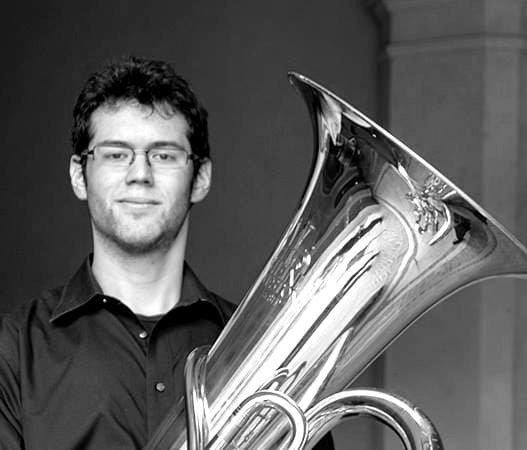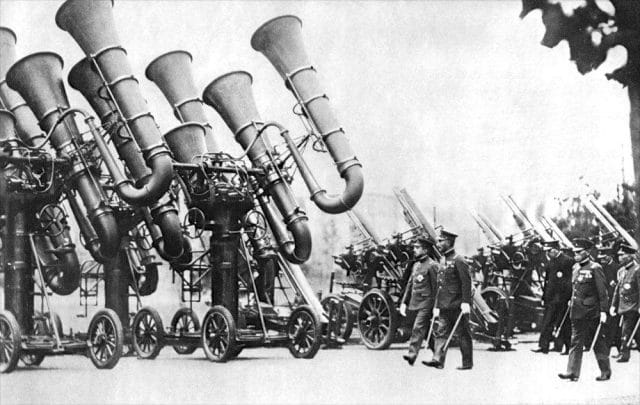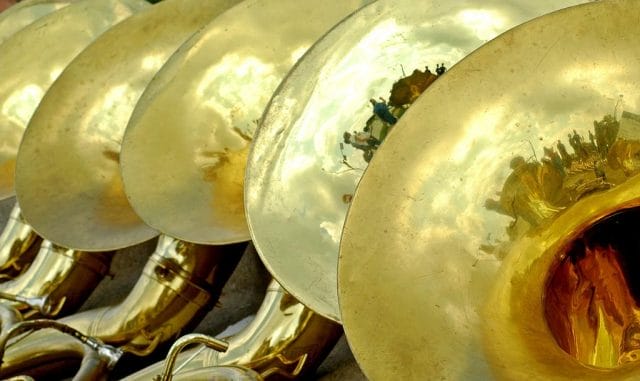If a man’s crazy just because he plays the tuba, then somebody’d better look into it, because there are a lot of tuba players running around loose.
— Longfellow Deeds, Mister Deeds Goes to Town
***
When Andres Trujillo fell in love for the first time, he fell in love with the tuba.
He was in a middle school pep band, playing the euphonium — the symphonic tuba’s diminutive cousin. One day, the band director approached him and asked if he’d be interested in trying the tuba. When that went well, the director suggested he switch instruments and join the school orchestra.
“I think I said, ‘Yeah, sure, I could do that,’” Trujillo remembers. “The instrument basically found me, probably because they didn’t have any tuba players at that middle school.”
In the years that followed, Trujillo’s tuba playing became a passion. He started playing outside of his school’s orchestra, got into jazz, wrote and arranged his own compositions. He picked up other instruments, too — bass, keyboard, guitar. But first and foremost, he remained a tubist. He was convinced he had found his calling. “It came to this point where I couldn’t imagine doing anything else,” he says.
This lead him down an unusually difficult career path only suited to the very talented, the very passionate, or the very stupid. Because, while the world of professional classical musicianship is insanely competitive in general, it turns out that it’s even worse for tubists than it is for other musicians. The reason lies in the numbers.
There are far fewer professional symphony orchestras out there than there are middle school orchestras, but as orchestras get more professional, most of their sections also get bigger. The most dramatic example of this is the strings section. This author remembers there being four violinists in her middle school orchestra, and two violas (one of whom was also one of the violinists). Professional symphony orchestras have 30 violins, and 12 violas.
The tuba section, unfortunately, does not scale-up as much. In fact, it doesn’t scale up at all: middle school orchestras have one tuba, and professional orchestras have one tuba. So, while getting a job as a professional violinist is difficult, the ratio of professionals to amateurs is higher than is the case for tubists. There are simply too many tubists out there; many more than the market can accommodate.
The Tubist, the Passionate
Trujillo and his tuba
Trujillo says he still can’t imagine a life outside of tuba-playing. “I have to do things to subsist, but I don’t really have plans to go into anything else for at least another four or five years.”
By “go into anything else,” he means pursue a career outside playing the tuba.
His origin story is typical among serious tubists. Whenever a middle school tubist graduates, the school’s music director sets out to recruit a student out of a different section. From then on, that tubist is the tubist in their orchestra. They’re the only person playing the tuba part, and the tuba part is loud. When they mess up, people notice — no more hiding in their section, behind the principal chair. This extra responsibility and power — and, for some, the magical, seductive quality of the tuba itself — turns kids who were just in the band to please their parents into true musicians.
Now, Trujillo is 25. Last May, he graduated with his master’s degree in tuba performance from the San Francisco Conservatory, one of the best music schools in the country. When he spoke with us, he was applying for a day job as an administrative assistant. “I’m looking for something more stable than my current set-up.”
His “current set-up” is pretty piecemeal. He teaches music, mostly tuba, both privately and through an institute. Some nights, he gigs with his brass band, Brass Band Mission. Other nights, he’ll back up touring rock groups, or play with a symphony when their tubist needs a sub.
He says he knows other players who make a living playing part time with several minor symphonies in the area, playing the so-called “Freeway Philharmonic.” They’ll play in Santa Rosa one night, Fremont the next, burn gas going back and forth between recitals, and also sub with the San Francisco symphony whenever they can get the work. Trujillo says this is an exhausting set-up, through which the musicians earn a lot of valuable orchestral experience, but they “can’t do it forever.”
Trujillo dreams of someday getting “the big gig,” which, in the world of classical music means becoming a tenured chair in a major symphony. But for that to happen, some professional tubist somewhere probably needs to die, or at least feel the sting of their mortality and retire. and that could take a while.
Big Baby Brass

Japanese “war tubas”, circa WWI (not actually tubas)
There’s a very good reason most orchestras only have one tuba.
First of all, the tuba is in the family of brass instruments. Brass instruments are the loudest family of acoustic instruments. This has to do with being made of metal — a hard and reflective material. The science behind the acoustics of volume and perceived volume is actually pretty complicated.
Second of all, tubas are deep.
On a basic level, this is how brass instruments work: The musician raspberries, or buzzes, into a mouthpiece, which is at the small end of an elaborate tube. The pitch of the sound that comes out of the wide end of the tube, known as the bell, partially depends on the way they buzz. The tubist can control the pitch by adjusting what is known as their embouchure: relaxing or constricting their lips as they buzz, similar to vocal chords.
Separate from embouchure, the pitch a musician produces through a brass insrument is determined by the length of its tube. Most modern brass instruments have valves which switch in tubing extensions of different lengths to allow musicians to play different pitches (one exception is the common trombones, which lets its players change the tube’s length with a continuous slide). But each instrument has a maximum length. Tubas come in several sizes and pitches. But in general the tuba is the lowest-pitched brass, because its tube, which is coiled up, is the longest — at about twice the length of a trombone’s.
Put another way: if an orchestra was a speaker set-up, the tuba would be the subwoofer, and its dial would go to 11. Orchestras need 30 violins to keep things balanced, or else, when the tuba played forte, they’d be drowned out by the instrument’s hypnotic, booming, brassy moan. Or its rhythmic “oom-pah-pah,” depending on the piece.
The One and Only

But having only one of your instrument in an orchestra has its drawbacks.
Say there’s a .1% chance of any given tuba chair turning over in a year, and a .1% chance of any given violin chair turning over, and there are 100 major symphony orchestras. There are 30 violinists in an orchestra, so there are 3,000 violin chairs out there, thus a 95% (1 minus the probability of none of the 3,000 chairs turning over, i.e. 1 – .999^3000) chance a chair will open up. But there’s only one tubist in each of those orchestras, thus only a 10% (1 – .999^100)chance of a chair opening up.
That means, in this hypothetical, that even if you were the best tubist in the world there’d be only a 10% chance you’d even have a chance to apply to audition for a major symphony orchestra this year. An extremely virtuosic violinist would know he’d get to audition several times in his twenties. A tubist wouldn’t. They could sit around for a decade, twiddling their thumbs, tutoring middle schoolers.
The odds aren’t quite that bad — an orchestral tuba position that pays a living wage opens up about two to three times a year. But the tougher job market does mean tubists are less likely to leave their chairs than other instrumentalists. If someone’s lucky enough to win a symphony chair, he or she typically sits in it for life. Carol Janstch, tubist for the Philadelphia Philharmonic, called actually being allowed to audition in a major symphony a “once-in-a-lifetime opportunity.”
“As luck would have it,” says Roger Bobo, former tubist for the L.A. Philharmonic, most of the people holding tuba chairs in major orchestras are “young and very good players.”
Bobo made headlines in 1961 when he was the first tuba soloist to play Carnegie Hall. The headlines inspired John Updike to write the poem ‘Recital’, which begins: “Eskimos in Manitoba / Barracuda off Aruba / Cock an ear when Roger Bobo / Starts to solo on the tuba.”
Then there are the odds of being selected in an audition. While other instrumentalists can afford to be a little choosier with their auditions, when a tuba chair opens up, practically every tubist in the world jumps on it. Even the chance for part-time work with the small-time orchestra of Springfield, Ohio drew international interest. Tuba chairs in major orchestras draw hundreds of applicants.
If your application is accepted, the process is “blind” from then-on out. Auditioners play from behind a curtain for a panel consisting of players from many sections in the orchestra. “If there’s a violinist who doesn’t like your sound, you’re out,” Trujillo reports. They go through several blind rounds, narrowing “about 100” auditioners down to 40, down to five, then down to two, before finally taking down the curtain and making their decision.
The worst part of all this is that there’s definitely no “entry level” tubist position. While a promising but inexperienced clarinettist with room to grow sometimes wins the fourth chair in an orchestra over a more seasoned professional, and then ascends the ranks to principal chair, the only tuba chair is the principal tuba chair. A top-tier tubist, sometimes one who already holds a chair and wants to graduate to a better-funded orchestra, almost always gets the spot.
This process might be why social change in the tuba world has been so glacial. Even though women have been principal chairs in major American symphony orchestras since the 1920s, the first female tubist in a major American symphony orchestra was Carol Jantsch in 2006.
The other side of the tuba coin is that while symphony orchestras only need one tubist, middle school orchestras need one tubist. So, even though the ultimate career opportunities are extremely limited, the mouth of the funnel is wide, and the stream is constant. Despite this general glut of labor in the professional market, thousands of students are recruited to tuba every year in schools across America.
Yes, there are more kids in every section of every middle orchestra than the classical music world can support, professionally. But it’s rare that a middle school orchestral section is kept in such steady proportion to professional ensembles. Some school orchestras, some years, get by with smaller-than-standard viola sections, or bassoon sections, or trombone sections. Every school orchestra feels pressure to have a full tuba section (i.e. one tubist), every year.
And many of the players in these other sections are afforded the luxury of hiding behind other, more skilled and dedicated players (the author, once a nominal violinist, knows from experience.)
But a student tubist has nowhere to hide. They either have to take it seriously and get up to snuff, or they drop out. This, in the immediate, is good because all of the out-of-work, conservatory-trained tubists out there seem to sustain themselves by tutoring middle schoolers and high schoolers. It might prove problematic in the long term, if a long-time tutor finally gets an audition and ends up competing with dozens of his former tuttees.
Some of these students, though nowhere near enough of them, are filtered out at the conservatory level. Certain schools, like the Curtis Institute of Music, only take one tuba student at a time. “That’s because I don’t believe in encouraging any more people in the business than there are already,” Curtis tuba instructor Paul Krzywicki has said. Not everybody has this philosophy. The San Francisco conservatory, for example, takes 45 violin students at a time, 1.5 times the number in a professional orchestra. It takes up to 5 tubists, or 5 times the number in a professional orchestra.
Hold it Tiger, Tuba Tiger
Experimental tuba composition by Øystein Baadsvik
“We’re not unique in the ‘only one’ department,” Zach Van Pelt admits. Van Pelt, who also holds his doctorate in tuba performance, is currently a box office manager. “But I still feel tuba has it the hardest,” he says. He points out that those other instruments — harp, piano, etc. — can get other work comparatively easily, accompanying other musicians or solo. Heck, even string players play solo gigs, or in chamber groups. When was the last time you went to a wedding with a tuba soloist?
That might be changing, slowly. Dixieland jazz and Balkan-style brass are both enjoying a bit of a revival. Mardis Gras season are fat times for tubists across the country. As these genres influence popular music, tubists get called in to gig pop and rock shows. A few years ago in Los Angeles, the emerging popularity of Mexican “banda” music lead to a run of tuba-targeted thefts in local high schools (the tubist is usually the leader of a banda band). And the glut of talented tubists — who have a tendency to evangelize their instrument — may eventually spawn a new form of music, or a new trend in current classical music.
In the UK, “amateur” brass bands have been popular since the 19th century, which of course eventually lead to brass acid house music
In the meantime, the market’s still pretty tight. Even in San Francisco, where brass groups are relatively plentiful, not every gig pays. “I was in three bands while I was in conservatory and had a bus pass,” says Trujillo — the SF Conservatory-trained tubist looking for administrative work. “I quit two of them because they just weren’t paying me. If I’m spending $2.25 on the bus to get to this rehearsal space, that’s $5 out of my pocket that I’m not going to get back.”
Trujillo says it would be great to win an orchestral seat, but his actual goal for his tuba career is to be able to, one way or another, simply make a living. “I’d like to pay my loans off, have a house at some point, have all the things that people with normal day jobs have,” he says. “I don’t want to sit in an office all day. But if by the time I’m 32 I don’t have insurance or a 401k, or all the things you’ve got to have, something’s got to give.”
He says he’s considering moving to somewhere like Texas, where unusually robust music programs in middle schools and high schools means teaching jobs are plentiful. In Texas he says he’ll be able to take on 10 to 20 students. In San Francisco, he only has three. Though he sometimes gives lessons in other instruments, like bass or keyboard, he says he isn’t nearly as qualified and can’t command the same fee.
“Tubists are not usually doublers,” Van Pelt says. He means tubists don’t usually play a second instrument at a comparable level. For instance, a violinist might double on the viola, meaning they can switch-hit in quartets when needed. “If a tubist does double, it’s usually on euphonium, which is not any more desirable!” The classic joke, of course being: What do you call a professional euphonium player who doesn’t play in a military band? Unemployed!
Playing in a military band is exactly what Almog Yarom, an 18-year-old Israeli tubist, and the brother of a Priceonomics engineer, recently tried to do. Non-classical genres of music featuring tuba aren’t as popular in Israel as they are in the United States, but there aren’t as many tuba players, either. He says there are only a few professional tuba players in the whole country.
Even so, competition can be stiff. Despite being an ocean away, Yarom’s teacher sounds like he’s in a remarkably similar position to Trujillo and Van Pelt. “My teacher studied at Juilliard,” Yarom says. “He came back to Israel and told me that he didn’t really have a chance of playing with a big orchestra because they all already had tubists. Smaller orchestras sometimes invite him in to play with them, but it’s part time.”
Yarom says doesn’t really know any other tuba players his age, and was competing with only three other students for the spot in the band. But, he didn’t pass. He’s only been playing tuba for three years, and all of his competitors had more experience. Now he’s looking for other ways to fulfill his government-mandated years of service, and putting his musical career on hold.
Whatever position he takes, Yarom will still try to practice every day. Symphonic tubists — many of whom have full time jobs playing in the symphony, and part time jobs teaching in conservatories — put in 4-6 hours of solo practice daily, on top of practicing with the symphony, to keep their chops up. But Trujillo says 4-8 hours a day of solo practice is also typical for aspiring professionals.
“That’s a real difficult thing to deal with,” he says. “If you’re spending all this time practicing and you’re not winning these jobs, your self worth can diminish. Your means of artistic expression is through this horn, when people aren’t hiring you for things, you can start to wonder what’s wrong with you.”
Often, the seduction of the tuba overwhelms the depression of rejection. Trujillo and Van Pelt are still doggedly pursuing their careers. Yarom, who is new enough to the tuba to get out while he still can, says he can’t imagine ever switching. “There’s something really satisfying about playing the bass of the musical piece,” he says.
It’s a sound Elizabeth Eshelman, amateur tubist and passionate tuba writer, calls “so dark and haunting, like the relief of a thick patch of shade on a sunny day.” It’s as if the right tubist playing the right song, is transmogrified from a fragile mortal into a supernatural force:
“[The bass voice] on the very bottom—that’s the tuba. […] When I hear [it, it] makes me think of how the ocean was once known as “the deep,” that lovely, lulling undertow.”
The true tubists of the world aren’t going to give that up easily, no matter the odds.
This post was written by Rosie Cima; you can follow her on Twitter here. To get occasional notifications when we write blog posts, please sign up for our email list




